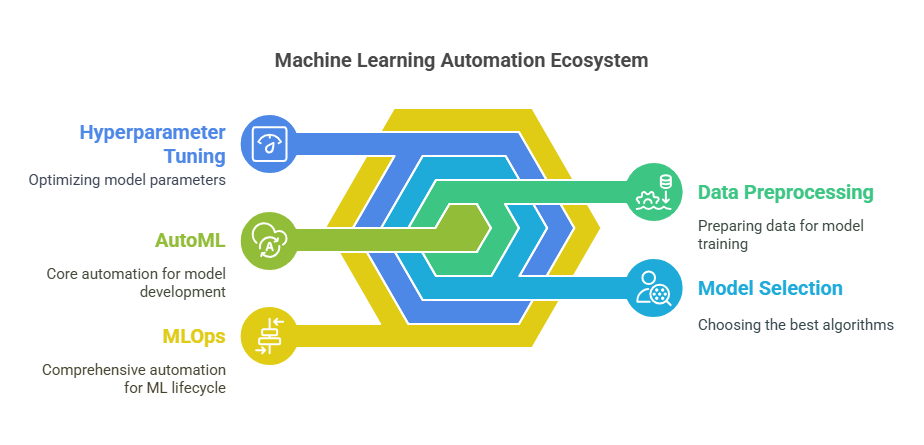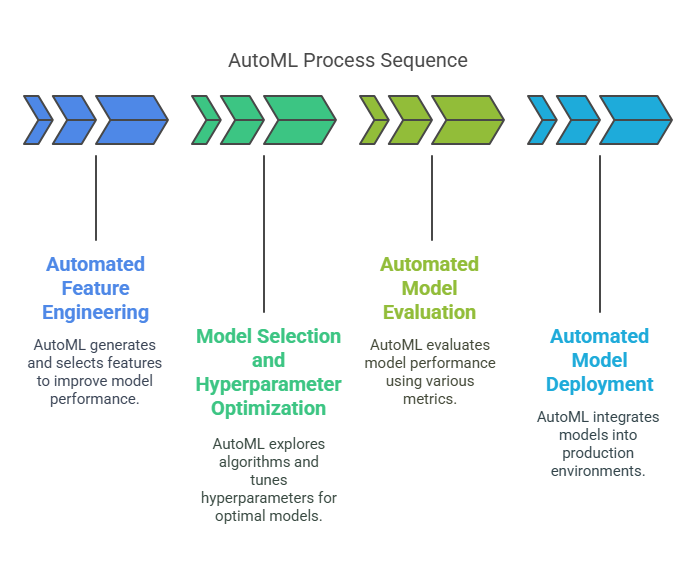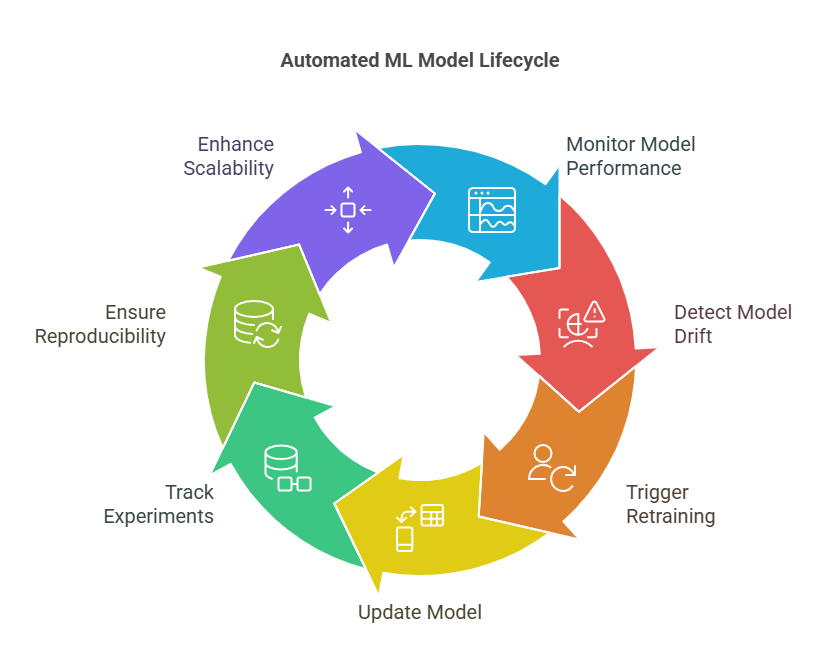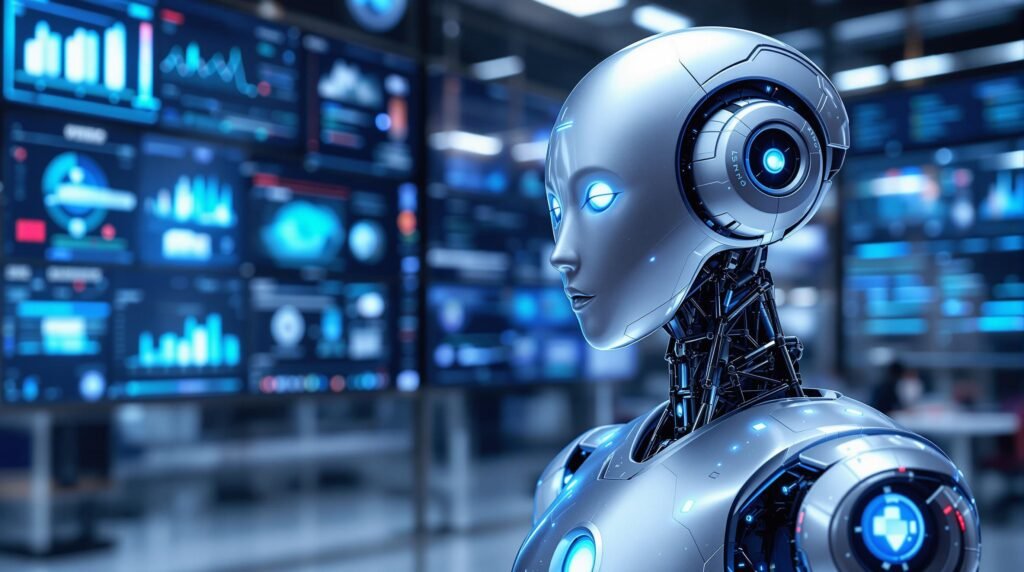Introduction
The Growing Need for Machine Learning Automation
Machine learning (ML) has become a cornerstone of modern technology, powering applications from personalized recommendations to autonomous vehicles. However, developing effective ML models traditionally requires significant expertise, time, and resources. Data scientists and engineers must manually preprocess data, select appropriate algorithms, tune hyperparameters, and deploy models — a complex and iterative process that can slow down innovation.
As organizations seek to scale their AI initiatives and democratize access to machine learning, automation has emerged as a critical solution. Automating the ML workflow reduces the dependency on specialized skills, accelerates model development, and enables faster deployment of AI-powered solutions. This growing need for automation has led to the rise of AutoML and other advanced tools designed to streamline and optimize the machine learning lifecycle.
What is AutoML?
AutoML, or Automated Machine Learning, refers to the use of software and algorithms to automate key steps in the machine learning process. This includes data preprocessing, feature engineering, model selection, hyperparameter tuning, and model evaluation. The goal of AutoML is to make machine learning more accessible to non-experts while improving efficiency and model performance.
By automating repetitive and time-consuming tasks, AutoML allows data scientists to focus on higher-level problem-solving and strategic decision-making. It also helps organizations rapidly prototype and deploy models, reducing the time from data to insight. AutoML platforms often provide user-friendly interfaces and integrate with existing data infrastructure, further lowering barriers to adoption.
Beyond AutoML: Exploring the Broader Landscape of Automation
While AutoML addresses many challenges in model development, the broader landscape of machine learning automation extends beyond these capabilities. Automation now encompasses data collection, data labeling, feature store management, model deployment, monitoring, and retraining — all critical components of a robust ML pipeline.
This expanded view includes MLOps (Machine Learning Operations), which integrates automation with software engineering best practices to ensure continuous integration, delivery, and governance of ML models. By looking beyond AutoML, organizations can build end-to-end automated workflows that improve scalability, reliability, and compliance in AI deployments.

Understanding AutoML
Key Components of AutoML Systems
AutoML systems typically automate several core components of the machine learning pipeline. These include:
Data Preprocessing: Cleaning, transforming, and preparing raw data for modeling, including handling missing values, normalization, and encoding categorical variables.
Feature Engineering: Automatically creating or selecting relevant features that improve model accuracy.
Model Selection: Evaluating multiple algorithms to identify the best-performing model for a given task.
Hyperparameter Optimization: Tuning model parameters to maximize performance without manual intervention.
Model Evaluation: Assessing model accuracy, precision, recall, and other metrics to ensure robustness.
Model Deployment: Automating the process of integrating the trained model into production environments.
By automating these steps, AutoML systems reduce manual effort and help deliver high-quality models faster.
Benefits of Using AutoML
AutoML offers several advantages for organizations adopting machine learning:
Accessibility: Enables users with limited ML expertise to build effective models.
Efficiency: Speeds up the model development process by automating repetitive tasks.
Consistency: Reduces human error and variability in model building.
Scalability: Facilitates rapid experimentation and deployment across multiple projects.
Performance: Often discovers models and hyperparameters that outperform manually tuned counterparts.
These benefits make AutoML an attractive option for businesses looking to accelerate AI adoption and maximize return on investment.
Limitations of AutoML
Despite its advantages, AutoML has some limitations:
Lack of Customization: Automated processes may not capture domain-specific nuances or complex problem requirements.
Data Quality Dependency: AutoML performance heavily depends on the quality and representativeness of input data.
Explainability Challenges: Some AutoML-generated models, especially complex ones, can be difficult to interpret.
Resource Intensive: Running multiple model evaluations and hyperparameter searches can require significant computational resources.
Not a Complete Solution: AutoML focuses mainly on model development and may not address other critical aspects like data governance, deployment, and monitoring.
Understanding these limitations helps organizations set realistic expectations and complement AutoML with human expertise and additional tools.
Core AutoML Techniques
Automated Feature Engineering
Feature engineering is a critical step in the machine learning process, involving the creation and selection of relevant features that improve model performance. Traditionally, this task requires deep domain knowledge and manual effort. AutoML automates feature engineering by using algorithms to generate new features, transform existing ones, and select the most informative features from the dataset.
Techniques such as feature construction, extraction, and selection are applied automatically to optimize the input data for modeling. For example, AutoML systems might create polynomial features, aggregate statistics, or encode categorical variables without human intervention. This automation not only speeds up the process but also helps uncover complex patterns that might be missed by manual feature engineering.
Model Selection and Hyperparameter Optimization
Choosing the right machine learning algorithm and tuning its hyperparameters are essential for building effective models. AutoML automates this by systematically exploring a wide range of algorithms and hyperparameter combinations to identify the best-performing model.
Model selection involves testing different algorithms such as decision trees, support vector machines, neural networks, or ensemble methods. Hyperparameter optimization techniques like grid search, random search, and Bayesian optimization are used to fine-tune parameters such as learning rate, tree depth, or regularization strength.
By automating these processes, AutoML reduces the trial-and-error effort typically required and often discovers models that outperform those manually designed by experts.
Automated Model Evaluation and Deployment
After training, models must be evaluated to ensure they meet performance criteria and are ready for deployment. AutoML systems automate model evaluation by calculating metrics such as accuracy, precision, recall, F1 score, and area under the curve (AUC) on validation datasets.
Once a model passes evaluation, AutoML platforms can also automate deployment steps, integrating the model into production environments or cloud services. This includes generating APIs, setting up monitoring tools, and managing version control. Automated deployment accelerates the transition from development to real-world application, enabling faster delivery of AI-powered solutions.

Popular AutoML Tools and Platforms
Google Cloud AutoML
Google Cloud AutoML offers a suite of machine learning products designed to simplify model building for users with varying levels of expertise. It provides tools for image, video, text, and tabular data, leveraging Google’s powerful infrastructure and pre-trained models. Google Cloud AutoML emphasizes ease of use with drag-and-drop interfaces and automated workflows, making it accessible for businesses looking to quickly develop custom AI models without deep ML knowledge.
Microsoft Azure AutoML
Microsoft Azure AutoML is part of the Azure Machine Learning service, providing automated model training, tuning, and deployment capabilities. It supports a wide range of algorithms and integrates seamlessly with Azure’s cloud ecosystem. Azure AutoML offers features like automated feature engineering, model interpretability, and pipeline automation, catering to both beginners and experienced data scientists.
DataRobot
DataRobot is an enterprise-grade AutoML platform that focuses on end-to-end automation of the machine learning lifecycle. It supports a broad array of data types and use cases, offering advanced capabilities such as explainable AI, model governance, and collaboration tools. DataRobot is widely used in industries like finance, healthcare, and retail to accelerate AI adoption and ensure compliance with regulatory standards.
Open-Source AutoML Libraries (e.g., Auto-sklearn, TPOT)
Several open-source AutoML libraries provide flexible and customizable solutions for automating machine learning tasks:
Auto-sklearn: Built on top of the popular scikit-learn library, Auto-sklearn automates algorithm selection and hyperparameter tuning using Bayesian optimization. It is well-suited for tabular data and supports ensemble learning.
TPOT (Tree-based Pipeline Optimization Tool): TPOT uses genetic programming to optimize machine learning pipelines, including feature preprocessing, model selection, and parameter tuning. It is designed to discover high-performing pipelines with minimal user input.
These open-source tools offer cost-effective options for researchers and developers who want to experiment with AutoML techniques and customize workflows.
Beyond AutoML: Expanding the Scope of Automation
Automated Data Collection and Preprocessing
While AutoML primarily focuses on automating model development, the broader automation landscape includes the crucial steps of data collection and preprocessing. Automated data collection involves gathering data from various sources such as databases, APIs, sensors, or web scraping tools without manual intervention. This ensures a continuous and up-to-date flow of data for machine learning models.
Automated preprocessing handles tasks like data cleaning, normalization, missing value imputation, and transformation. By automating these steps, organizations reduce human error, save time, and ensure consistent data quality. Tools that integrate data pipelines with preprocessing workflows enable seamless preparation of data, which is essential for reliable model training and evaluation.
Automated Feature Store Management
Feature stores are centralized repositories that store, manage, and serve features for machine learning models. Automated feature store management involves the systematic cataloging, versioning, and sharing of features across teams and projects. This automation ensures that features are consistent, reusable, and up-to-date, reducing duplication of effort and improving collaboration.
By automating feature engineering and storage, organizations can accelerate model development and maintain data integrity. Feature stores also support real-time feature serving, enabling models to make predictions with fresh data in production environments.
MLOps and Continuous Integration/Continuous Deployment (CI/CD) for ML
MLOps extends automation to the operational aspects of machine learning, combining best practices from DevOps with ML-specific workflows. It includes automating model training, testing, deployment, monitoring, and retraining to create a continuous integration and continuous deployment (CI/CD) pipeline for ML.
Automated CI/CD pipelines help ensure that models are consistently updated with new data, performance is tracked, and any degradation is promptly addressed. This approach improves scalability, reliability, and governance of AI systems, enabling organizations to deploy ML models faster and with greater confidence.
Integrating AutoML into MLOps Pipelines
Automating Model Retraining and Monitoring
In production environments, machine learning models can degrade over time due to changes in data distribution or external factors—a phenomenon known as model drift. Integrating AutoML into MLOps pipelines allows for automated retraining of models when performance drops below a threshold.
Automated monitoring tools track key performance metrics and data quality indicators in real time. When anomalies or degradation are detected, the system can trigger retraining workflows using AutoML techniques to update the model with fresh data, ensuring sustained accuracy and relevance.
Version Control and Experiment Tracking
Effective management of machine learning experiments and model versions is critical for reproducibility and collaboration. Integrating AutoML with version control systems enables tracking of datasets, code, model configurations, and results.
Experiment tracking tools record metadata such as hyperparameters, training duration, and evaluation metrics, allowing data scientists to compare different runs and select the best model. Automated logging and versioning facilitate auditing, rollback, and compliance with regulatory requirements.
Ensuring Reproducibility and Scalability
Reproducibility is a cornerstone of trustworthy AI. By embedding AutoML within standardized MLOps pipelines, organizations can ensure that model training and deployment processes are consistent and repeatable across different environments.
Scalability is also enhanced through automation, as pipelines can handle increasing volumes of data and model complexity without manual intervention. Cloud-based platforms and containerization technologies support scalable infrastructure, enabling organizations to deploy AI solutions at enterprise scale efficiently.

Case Studies: Real-World Applications of Automated Machine Learning
Automating Predictive Maintenance in Manufacturing
Predictive maintenance is a critical application of machine learning in manufacturing, where the goal is to predict equipment failures before they occur to minimize downtime and reduce costs. Traditionally, building predictive models required extensive manual data analysis and feature engineering. With AutoML, manufacturers can automate the entire process—from data preprocessing to model selection and tuning—enabling faster deployment of predictive maintenance solutions.
For example, an industrial company used AutoML to analyze sensor data from machinery, automatically identifying patterns that indicate potential failures. This automation reduced the time to develop accurate models from months to weeks, resulting in significant cost savings and improved operational efficiency.
Enhancing Customer Service with Automated Chatbots
Customer service is another domain benefiting from AutoML. Developing natural language processing (NLP) models for chatbots typically involves complex tasks such as intent recognition, entity extraction, and dialogue management. AutoML platforms simplify this by automating model training and optimization, allowing businesses to quickly build and deploy chatbots that understand and respond to customer queries effectively.
A retail company leveraged AutoML to create a chatbot that handles common customer inquiries, freeing up human agents to focus on more complex issues. The automated approach enabled rapid iteration and continuous improvement of the chatbot’s performance based on real-world interactions.
Improving Fraud Detection in Financial Services
Financial institutions face constant threats from fraudulent activities, making fraud detection a high-stakes application of machine learning. AutoML helps by automating the development of models that analyze transaction data to identify suspicious patterns and anomalies.
One bank implemented an AutoML solution to monitor millions of transactions daily, automatically updating models to adapt to evolving fraud tactics. This automation improved detection accuracy and reduced false positives, enhancing security while maintaining customer satisfaction.
Challenges and Considerations
Data Quality and Bias in Automated Systems
While AutoML can accelerate model development, it is highly dependent on the quality of input data. Poor data quality, such as missing values, noise, or unrepresentative samples, can lead to inaccurate or biased models. Moreover, if the training data contains historical biases, AutoML may inadvertently perpetuate these biases, resulting in unfair or discriminatory outcomes.
Organizations must implement rigorous data validation, cleansing, and bias detection processes alongside AutoML to ensure ethical and reliable models. Human oversight remains essential to identify and mitigate data-related issues that automation alone cannot resolve.
Explainability and Interpretability of Automated Models
Many AutoML-generated models, especially complex ones like deep neural networks or ensemble methods, can be difficult to interpret. Lack of explainability poses challenges in regulated industries where understanding model decisions is critical for compliance and trust.
To address this, organizations should incorporate explainability tools and techniques, such as SHAP (SHapley Additive exPlanations) or LIME (Local Interpretable Model-agnostic Explanations), into their AutoML workflows. Transparent reporting and user-friendly explanations help stakeholders understand and trust AI-driven decisions.
Skill Requirements and the Role of Data Scientists
Although AutoML reduces the need for manual model building, it does not eliminate the need for skilled data scientists. Expertise is still required to define problem statements, prepare data, interpret results, and integrate models into business processes.
Data scientists also play a crucial role in overseeing AutoML outputs, validating model performance, and ensuring ethical considerations are met. Organizations should view AutoML as a tool that augments human expertise rather than replaces it.
Future Trends in Machine Learning Automation
AI-Driven AutoML
The future of machine learning automation is increasingly shaped by AI-driven AutoML systems that leverage advanced techniques such as meta-learning and neural architecture search. These systems learn from past modeling experiences to optimize new tasks more efficiently, reducing the need for extensive trial and error. AI-driven AutoML aims to create models that are not only accurate but also more adaptable to changing data and environments, enabling continuous learning and improvement.
This trend promises to further democratize machine learning by making it accessible to a broader audience, including those without deep technical expertise. As these systems evolve, they will likely incorporate more sophisticated reasoning and decision-making capabilities, pushing the boundaries of what automated ML can achieve.
Federated Learning and Automated Model Sharing
Federated learning is an emerging approach that enables multiple organizations or devices to collaboratively train machine learning models without sharing raw data. This technique enhances privacy and security by keeping sensitive data localized while still benefiting from collective learning.
Automation plays a key role in federated learning by managing the coordination, aggregation, and updating of models across distributed nodes. Automated model sharing and updating mechanisms ensure that all participants benefit from improvements without compromising data privacy. This approach is particularly valuable in sectors like healthcare and finance, where data confidentiality is paramount.
The Convergence of AutoML and MLOps
The integration of AutoML with MLOps practices represents a significant future trend in machine learning automation. Combining automated model development with robust operational workflows enables end-to-end automation—from data ingestion and model training to deployment, monitoring, and retraining.
This convergence facilitates scalable, reliable, and maintainable AI systems that can adapt quickly to new data and business requirements. Organizations adopting this integrated approach can accelerate AI innovation while ensuring governance, compliance, and continuous performance optimization.
Conclusion
Key Takeaways
Automation in machine learning, led by AutoML and extended through MLOps, is transforming how organizations develop and deploy AI solutions. By automating repetitive and complex tasks, these technologies reduce barriers to entry, accelerate innovation, and improve model quality. However, successful automation requires careful attention to data quality, ethical considerations, and ongoing human oversight.
The future of machine learning automation is promising, with advances in AI-driven AutoML, federated learning, and integrated MLOps pipelines paving the way for more intelligent, scalable, and secure AI systems. Organizations that embrace these trends while maintaining a focus on transparency, fairness, and accountability will be best positioned to harness the full potential of AI.
The Future of Automated Machine Learning
As automated machine learning continues to evolve, it will increasingly empower businesses to solve complex problems faster and more effectively. The combination of automation, advanced AI techniques, and operational best practices will enable continuous learning and adaptation, making AI systems more resilient and responsive.
Looking ahead, collaboration between humans and machines will remain essential. Automation will augment human expertise, freeing data scientists and engineers to focus on strategic challenges and innovation. By balancing automation with ethical responsibility and governance, the future of machine learning promises to be both powerful and trustworthy.
AI Agent Lifecycle Management: From Deployment to Self-Healing and Online Updates
AI Agents in Industry: Revolutionizing Manufacturing and Logistics
Advanced Deep Learning Techniques: From Transformers to Generative Models


